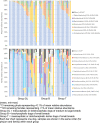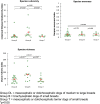Variations in facial conformation are associated with differences in nasal microbiota in healthy dogs
- PMID: 34819074
- PMCID: PMC8611846
- DOI: 10.1186/s12917-021-03055-w
Variations in facial conformation are associated with differences in nasal microbiota in healthy dogs
Erratum in
-
Correction to: Variations in facial conformation are associated with differences in nasal microbiota in healthy dogs.BMC Vet Res. 2022 Mar 16;18(1):100. doi: 10.1186/s12917-022-03209-4. BMC Vet Res. 2022. PMID: 35296323 Free PMC article. No abstract available.
Abstract
Background: Extrinsic and intrinsic factors have been shown to influence nasal microbiota (NM) in humans. Very few studies investigated the association between nasal microbiota and factors such as facial/body conformation, age, and environment in dogs. The objectives are to investigate variations in NM in healthy dogs with different facial and body conformations. A total of 46 dogs of different age, living environment and from 3 different breed groups were recruited: 22 meso-/dolichocephalic medium to large breed dogs, 12 brachycephalic dogs and 12 terrier breeds. The nasal bacterial microbiota was assessed through sequencing of 16S rRNA gene (V1-V3 regions) amplicons.
Results: We showed major differences in the NM composition together with increased richness and α-diversity in brachycephalic dogs, compared to meso-/dolichocephalic medium to large dogs and dogs from terrier breeds.
Conclusion: Healthy brachycephalic breeds and their unique facial conformation is associated with a distinct NM profile. Description of the NM in healthy dogs serves as a foundation for future researches assessing the changes associated with disease and the modulation of NM communities as a potential treatment.
Keywords: Breed; Dogs; Facial conformation; Microbiota; Nasal cavity.
© 2021. The Author(s).
Conflict of interest statement
The authors declare that they have no competing interests.
Figures







References
MeSH terms
Substances
LinkOut - more resources
Full Text Sources

